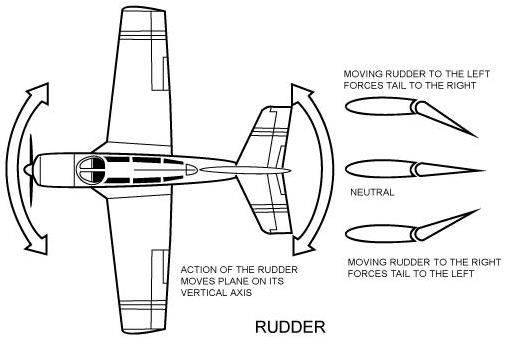
Directional control about the vertical axis of the airplane is obtained through the use of the rudder. The rudder is a movable surface hinged to the trailing edge of the vertical stabilizer (fin) and attached by mechanical linkage to the rudder pedals located in the cockpit. By pressing the right rudder pedal, the rudder is deflected to the right, which causes the relative wind to deflect the tail to the left and the nose to the right. If left rudder pressure is applied, the reverse action occurs and the nose is deflected to the left. It should be understood that the purpose of the rudder during flight is to control yaw and not to turn the airplane. [Figure 1-31]
 |
|
|
The amount of control which the pilot has over the airplane is dependent upon the speed of the airflow striking the control surfaces. Effective airplane stability also depends upon speed of the airplane through the air. The greater the airspeed the greater the effect of stability as a restoring force.
LOADS AND LOAD FACTORS
An airplane is designed and certificated for a certain maximum weight during flight. This weight is referred to as the maximum certificated gross weight. It is important that the airplane be loaded within the specified weight limits before flight, because certain flight maneuvers will impose an extra load on the airplane structure which may, particularly if the airplane is overloaded, impose stresses which will exceed the design capabilities of the airplane. Overstressing the airplane can also occur if the pilot engages in maneuvers creating high loads, regardless of how the airplane is loaded. These maneuvers not only increase the load that the airplane structure must support, but also increase the airplane’s stalling speed.
The following will explain how extra load is imposed upon the airplane
during flight. During flight, the wings of an airplane will support the
maximum allowable gross weight of the airplane. So long as the airplane
is moving at a steady rate of speed and in a straight line, the load imposed
upon the wings will remain constant. A change in speed during straight
flight will not produce any appreciable change in load, but when a change
is made in the airplane’s flightpath, an additional load is imposed upon
the airplane structure. This is particularly true if a change in direction
is made at high speeds with rapid forceful control movements.
According to certain laws of physics, a mass (airplane in this
case) will continue to move in a straight line unless some force intervenes,
causing the mass (airplane) to assume a curved path. During the time the
airplane is in a curved flightpath, it still attempts, because of inertia,
to force itself to follow straight flight. This tendency to follow straight
flight, rather than curved flight, generates a force known as centrifugal
force which acts toward the outside of the curve.
Any time the airplane is flying in a curved flightpath with a
positive load, the load the wings must support will be equal to the weight
of the airplane plus the load imposed by centrifugal force. A positive
load occurs when back pressure is applied to the elevator, causing centrifugal
force to act in the same direction as the force of weight. A negative load
occurs when forward pressure is applied to the elevator control, causing
centrifugal force to act in a direction opposite to that of the force of
weight.
Curved flight producing a positive load is a result of increasing
the angle of attack and consequently the lift. Increased lift always increases
the positive load imposed upon the wings. However, the load is increased
only at the time the angle of attack is being increased. Once the angle
of attack is established, the load remains constant. The loads imposed
on the wings in flight are stated in terms of load factor.